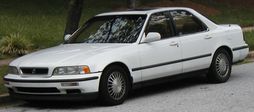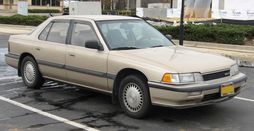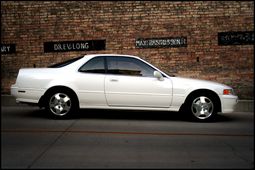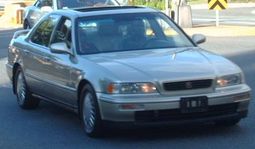The History Of Acura Legend

The Acura Legend, sold as the Honda Legend outside the U.S., Canada, and parts of China, was a sporty luxury vehicle sold from 1986 to 1995 as both a sedan and a coupe. It was one of the first vehicles sold under the Acura nameplate, and was the top-spec sedan under the Acura nameplate until being replaced in 1996 by the Acura RL (officially badged as the Acura 3.5RL). The 3.5RL was a rebadged version of the third generation Honda Legend.
Honda introduced the model in 1985 in Japan to be their premier luxury model and in 1986 North America as the range-topping model in its then-new Acura lineup. Sedan models came to market first, powered by a 151hp (113kW) 2.5L C25A V6 with coupes appearing for 1987 powered by a new 161hp (120kW) 2.7L C27A engine. Sedans received the new engine for 1988. Production of the first generation models ended in 1990 as a second generation version became available.
The Legend won Car and Driver's Ten Best three years in a row and Motor Trend's "Import Car of the Year" for 1987. Manual-equipped models could sprint to 60mph (97km/ h) in under 8 seconds and reach a top speed of 135mph (217km/ h). Sedan models had a coefficient of drag of .32, while coupes were only .30.
Technical highlights included a 24-valve V6 engine, variable length intake manifold, double-wishbone suspension, 4-wheel disc brakes, air bag and an information system that could monitor maintenance intervals, fluid levels, and fuel economy.
In 1989, the sedan received some minor tweaks with new one-piece front headlamps, a new front bumper, a revised trunk lid, new tail lights, and new alloy wheels. Inside, a revised dash and seat cloth patterns is also noticeable. By that time all Legends came equipped with a driver airbag and 4-wheel anti-lock brakes. High end LS models featured a trip computer and electronic vehicle monitoring system in the center console and a Bose sound system.
For the 1990 model year, all Legends received body-colored side mirrors. Legend coupes received a revised body-colored front grille, new red & clear tail lights, and improved front seats. LS model coupes also received a trunk-mounted lip spoiler. LS models received burlwood interior trim.
Second generation units became available for the 1991 model year, now using a 200hp (150kW) SOHC (C32A) engine mated to either a standard 5-speed manual or an optional 4-speed automatic. The second generation Legend was a larger, more streamlined-looking car (drag coefficients were actually higher at .34 for sedans and .32 for coupes). The Legend offered a host of features seen on luxury cars of today including speed-sensitive steering, hands-free telephone, automatic climate control, heated leather seats, heated mirrors, 4-wheel ABS disc brakes, seat belt pretensioners and soft-close vacuum-operated doors (coupes only).
For 1991 and 1992 the Legend sedan was available in Base, L, and LS trims; the coupe remained available in L and LS through its entire run. The higher-end LS cars added climate control, a power 4-way passenger seat, burled walnut interior trim, and body colored side moldings. Honda made significant upgrades for 1993, making a 230hp (172kW) "Type II" version of the SOHC C32A engine standard on all coupes, along with a 6-speed manual transmission. 1993 also saw the addition of dual airbags as standard equipment all trims, the deletion of the black molding on the entry level cars, and a new wheel design with fewer spokes on the sedans (16 spoke vs. 20 spoke). The Type-II manual transmission coupe posted a quarter mile time of 15.3 seconds with a 0-60 mph time of 6.6 seconds, and had a top speed of 163mph (262km/ h).
In 1994, all Legends received new front bumpers, a new front grille (L&LS Sedans only), revised trunk lids, and a power tilt-telescoping steering column; the word "Legend" was now spelled out in individual letters on the back. The base sedan, 4DR STD transmission, was dropped, while a new GS sedan became the new top-line variant, sporting the 230hp (172kW) "Type II" engine, upgraded brakes from the coupe, sport suspension from the coupe, a body colored version of the 1991 to 1993 grille, the same standard 6-speed manual found on the coupes as well as the special 16" 5 spoke LS Coupe wheels (Better known as "GS Wheels"). Also in 1994, the LS version of the sedan lost the standard manual transmission, it was only available with an automatic transmission.
Added for 1995 was a limited-production SE sedan -- essentially a Legend L with a two-tone paint scheme, pre-1993 15" 7 spoke LS Coupe wheels, "Special Edition" floor mats, and automatic transmission.
- The 1st generation Legend shared its engine, transmission, some chassis and other parts with the Rover 800-series models, sold in the United States under the Sterling brand. The 1st generation of Legends was co-developed with Rover group and sold under the Rover name in the UK and France.
- The Japan Domestic Market version of the 1990 Legend (2nd generation) was the first vehicle offered with a navigation system, although it was not satellite-based and instead relied on accelerometers.
- The "replacement" for the Legend sedan is sold as the Acura RL in North America, although Honda continues to sell it as the Legend in most other areas of the world.
- The tooling and intellectual property rights of the second generation Legend were licensed to Daewoo Motors of South Korea, where a clone of the Legend sedan, called the Daewoo Arcadia, was produced from 1993 to 2000. During this period, Honda also held a small stake in Daewoo Motors.
- On an episode of MTV's reality show "Cribs", hip-hop artist Ludacris owns a 1993 Acura Legend Sedan, which he calls his favorite car.
The Legend coupe was Motor Trend's Import Car of the Year for 1987. The coupe also made Car and Driver magazine's Ten Best list for 1988 through 1990.
From Wikipedia, the free encyclopedia
More About Acura Legend





|